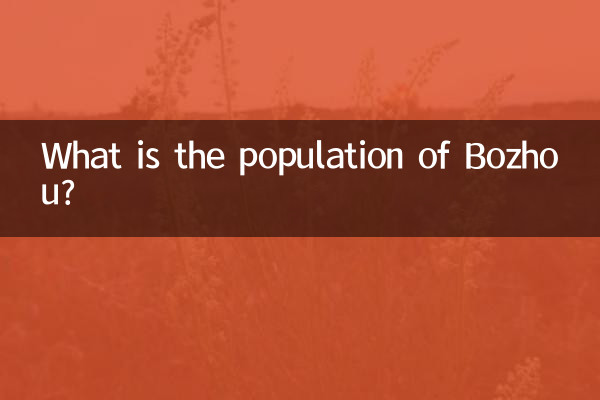What is the population of Bozhou? Analyze the latest population data and hot topics in Bozhou City
Recently, the population data of Bozhou City has become one of the focuses of attention of netizens. As an important city in Anhui Province, Bozhou is not only famous for its traditional Chinese medicine culture, but its population changes also reflect the dynamics of regional development. This article will give you a detailed explanation of Bozhou’s population status and development trends based on the hot content on the entire Internet in the past 10 days.
1. Latest population data of Bozhou City

According to the latest statistics in 2023, the data of Bozhou City’s permanent population and registered population are as follows:
| Statistics type | Population (10,000 people) | Data source | Statistical year |
|---|---|---|---|
| permanent population | 499.8 | Anhui Provincial Bureau of Statistics | 2023 |
| Registered population | 655.2 | Bozhou Municipal Public Security Bureau | 2023 |
It can be seen from the data that there is an obvious difference between the registered population and the permanent population in Bozhou City, which is consistent with the large number of migrant workers.
2. Population distribution among counties and districts in Bozhou City
Bozhou City has three counties and one district under its jurisdiction, and its population is unevenly distributed:
| Administrative division | Permanent population (10,000 people) | Proportion of the city |
|---|---|---|
| Qiaocheng District | 152.3 | 30.5% |
| Woyang County | 117.6 | 23.5% |
| Mengcheng County | 110.4 | 22.1% |
| Lixin County | 119.5 | 23.9% |
As the main urban area of Bozhou City, Qiaocheng District has an obvious population agglomeration effect, accounting for more than 30% of the total population.
3. Hot topics about Bozhou on the Internet in the past 10 days
By analyzing the data of the entire network, recent hot topics related to Bozhou mainly focus on the following aspects:
| Topic Category | heat index | Main discussion content |
|---|---|---|
| Development of traditional Chinese medicine industry | 85 | Bozhou Traditional Chinese Medicine Market Expansion Plan |
| population movement | 76 | The trend of migrant workers returning home |
| urban construction | 68 | Bozhou Airport Construction Progress |
| cultural tourism | 62 | Preparations for Cao Cao’s Hometown Cultural Festival |
4. Analysis of Bozhou’s population development trend
According to the data of the past five years, the population of Bozhou City shows the following characteristics:
| Year | Permanent population (10,000 people) | Changing trends |
|---|---|---|
| 2019 | 516.3 | ↓ |
| 2020 | 510.2 | ↓ |
| 2021 | 505.7 | ↓ |
| 2022 | 502.1 | ↓ |
| 2023 | 499.8 | ↓ |
It can be seen from the data that the permanent population of Bozhou City is showing a slow downward trend, with an average annual decrease of about 30,000 to 40,000 people. This is consistent with the overall population flow trend in Anhui Province to the Yangtze River Delta region.
5. Main factors affecting Bozhou’s population changes
1.economic factors: Bozhou is dominated by agriculture and traditional Chinese medicine industries, and its industrial base is relatively weak, resulting in a large number of labor outflows.
2.transportation development: With the opening of the Shanghe-Hangzhou high-speed railway, Bozhou has become more closely connected with cities in the Yangtze River Delta, accelerating population mobility.
3.Impact of fertility policy: Despite the full liberalization of the two-child policy, Bozhou’s fertility rate is still below the population replacement level.
4.urbanization process: The county population continues to concentrate in the main urban areas, and the population in towns and villages has decreased significantly.
6. Expert opinions: challenges and opportunities for Bozhou’s population development
Professor Zhang from the Institute of Regional Economics of Anhui University pointed out: "The demographic challenge faced by Bozhou is a microcosm of the cities in northern Anhui Province. It is recommended to start from three aspects: first, speed up industrial upgrading and create more local employment opportunities; second, improve public services, especially education and medical resources; third, give full play to the characteristics of traditional Chinese medicine and create an attractive talent policy."
The relevant person in charge of the Bozhou Municipal Development and Reform Commission said: "We are formulating a new population development plan, focusing on attracting professional talents through the construction of the 'World Capital of Traditional Chinese Medicine'. It is expected that the downward trend of the permanent population will be curbed by 2025."
Conclusion
Bozhou City currently has a permanent population of approximately 4.998 million and is in a critical period of population structure adjustment. With the rise of the traditional Chinese medicine industry and the improvement of infrastructure, this historical and cultural city is expected to usher in a new population development pattern. Understanding Bozhou's population data will not only help grasp the pulse of urban development, but also provide important reference for investment, employment and other decisions.

check the details

check the details